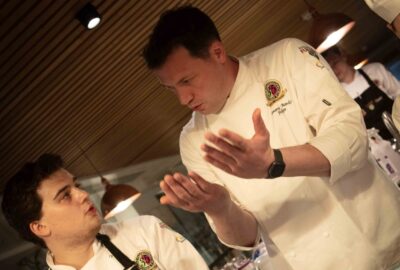Chef Simon Rimmer is a regular on our TV screens, hosting Sunday Brunch on Channel 4 with Tim Lovejoy, as well as appearing on Great British Menu and Saturday Kitchen, along with various food-related documentary series. He co-owns several restaurants and gastro pubs in the UK and Dubai including Green’s, a vegetarian restaurant in Manchester.
You bought a restaurant in 1990 – but had no culinary experience. What were you thinking – and how did you manage to pull it off? When I was a student I worked front of house in bars and restaurants, and I just fell in love with the industry. When I left university, I worked as a freelance designer but I always had this nagging feeling in the back of my mind. I really missed working in food and drink so my business partner and I said ‘Let’s take a chance’ and we bought Greens. We were lucky with the location in a part of Manchester that was becoming quite cool. There wasn’t the competition that there is today and customers were nowhere near as sophisticated. It was a lot of luck, hard work and a lot of joy.
What benefits does being a self-taught chef bring? I didn’t know what was right and wrong so I was pretty creative! It was all about instinct and what ‘felt right’. I had a child-like excitement which still hasn’t stopped. The downside was that I had to learn backwards because my rudimentary skills weren’t as good as my creative skills, so I had to learn things like filleting fish and how to butcher meat.
As a busy TV chef, how much time do you actually get to spent in the kitchen of your restaurants/gastro pubs? I’m on site every day that I’m not filming but I don’t do anywhere near as much service as I used to. I’ve done my time standing at the stove – it’s a young man’s job! Instead I’m in the kitchen developing new dishes and chefs.
You’re a champion of “magpie cuisine”. Tell us more. Not being trained, I would look at something I liked and think ‘I’ll use that’ but not in a conventional way. So maybe taking Jamaican rice and peas and putting it with a Japanese influence – and making it work together. I’ll steal ideas from anywhere!
Is vegetarian food becoming more popular amongst meat-eaters? It goes in peaks and troughs. There are times where a new wave of people want to go down that route – and we’re in the midst of one at the moment. People seem to be eating a varied diet and choosing to go meat-free on a regular basis. There are others who choose a plant-based diet but aren’t vegans because they wear leather shoes and jackets. It’s really interesting and you have to respond to the needs of the customers. Greens has been going for 27 years and, at the moment 70% of our dishes are vegan, but two years ago it was 30%.
What advice can you offer fellow chefs when planning their vegetarian offering? Meat and two veg is the staple of most menus but veg and two veg doesn’t work so you have to make the dish balance in a different way. If you’ve got a fillet steak, it’s job done, but you can’t do that with aubergines. You need to be more creative. Flavour, texture and appearance are what make a great dish.
Brunch, as a meal occasion, is now very much in vogue. Why do you think that is – and what would be your perfect brunch? People just eat out more and aren’t restricted to specific times. Four years ago the brunch concept was alien outside of London but dining habits have changed and people tend to graze now. Brunch has revolutionised weekend dining. My ideal brunch would be an overload of bacon with American sour pancakes, maple syrup, orange and carrot juice and as much coffee as you could throw at me.
Your recent TV series ‘Eat the Week with Iceland’ showed busy families how to make healthy, tasty food using frozen products. Do you think there is still a “snob factor” around professional chefs using frozen products? What is your favourite frozen product and why? Yes I do think that some chefs believe frozen isn’t as good as fresh even though in blind tastings, frozen is at least as good as fresh in terms of flavour profile. I made a documentary about this and was pleasantly surprised. Frozen peas are one the greatest things you can buy and are brilliantly versatile.
As a restaurateur presenting Channel 4’s Tricks of the Restaurant Trade, what’s the best ‘trick’ you’ve come across? Upselling is one the greatest things restaurants can do, as long as it’s done well. It’s about making it fun and not forcing something down your throat. Diners appreciate getting really good advice and recommendations but you have to train your staff properly. Knowledgeable staff make all the difference.
And now for three questions that we ask all of our Leading Lights…
1. What are your three kitchen secrets? i) Always make sure your protein is at room temperature before you cook it. ii) Acidity can save many dishes (but not cream-based). If your dish tastes bland, add a teaspoon of any kind of vinegar and it will bring it to life and stimulate the tastebuds. iii) You don’t need to spend hours peeling butternut squash. Roast it with the skin on and eat the whole thing – it’s delicious.
2. What is your favourite ingredient and why? Rose water – it’s amazing with anything containing red fruits or with grains like quinoa and cous cous. One spoonful magically lifts the dish but no one can work out what it is.
3. Please could you share your favourite recipe, along with your reasons for choosing it? I love chicken thighs. The meat has so much more flavour and texture than breast. And they love a good massage with a succulent marinade. This dish is dead simple but delicious. Splitting the marinade in half is really interesting. One half gets cooked with the chicken whilst the other stays raw. So when you eat it you know the two flavours are related but they have a distinct difference. Think of it like being at a family party – you can tell you’re related to most of the people but you don’t look exactly alike!
Chicken Thighs with Marinated Tomatoes
Ingredients
12 x skinless and boneless chicken thighs
6 plum tomatoes, cut into quarters
300g cooked brown rice
6 finely chopped spring onions
Parmesan, finely grated to garnish
Marinade
250ml extra virgin olive oil
3 cloves garlic
50g soft dark brown sugar
Zest and juice of 1 lemon
15g sea salt
15g smoked paprika
30ml sherry vinegar
30g finely chopped rosemary
5g turmeric
Method
1. Marinade – mix it all together, then divide into two bowls.
2. Put chicken in one and tomatoes in the other. Cover and leave both overnight.
3. Next day take the chicken out of the marinade and roast at 200°C for about 20 minutes.
4. Mix the onions with the rice.
5. Serve tomatoes and marinade on top of the rice, then chicken, garnish with cheese.



